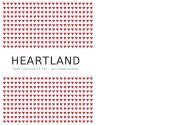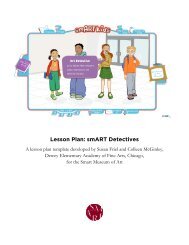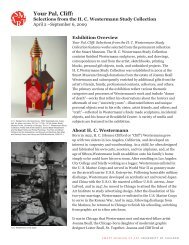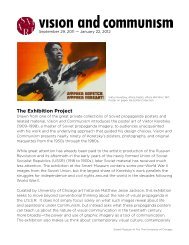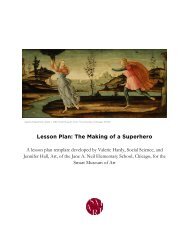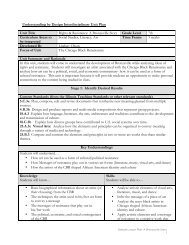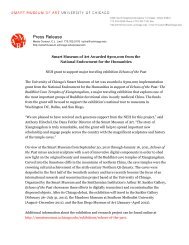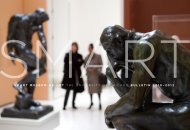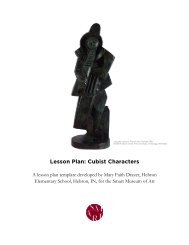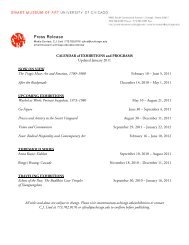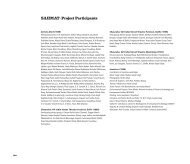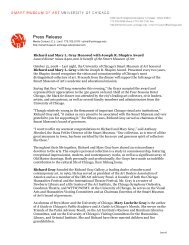Art in Focus (3rd grade) curriculum (PDF) - Smart Museum of Art ...
Art in Focus (3rd grade) curriculum (PDF) - Smart Museum of Art ...
Art in Focus (3rd grade) curriculum (PDF) - Smart Museum of Art ...
Create successful ePaper yourself
Turn your PDF publications into a flip-book with our unique Google optimized e-Paper software.
<strong>Art</strong> <strong>in</strong> <strong>Focus</strong> Curriculum<br />
A multi-visit tour program <strong>of</strong>fered by the University <strong>of</strong> Chicago’s<br />
<strong>Smart</strong> <strong>Museum</strong> <strong>of</strong> <strong>Art</strong> for Chicago Public Schools third <strong>grade</strong> classrooms
MUSEUM VISIT 1: Elements <strong>of</strong> <strong>Art</strong><br />
OBJECTIVES<br />
• I can understand the purpose and function <strong>of</strong> an art museum.<br />
• I can identify basic elements <strong>of</strong> art (l<strong>in</strong>e, shape, color, texture).<br />
• I can discuss how the elements <strong>of</strong> art work together to create a composition.<br />
• I can identify representational and abstract works <strong>of</strong> art.<br />
DESCRIPTION<br />
In this <strong>in</strong>troductory visit to the <strong>Smart</strong> <strong>Museum</strong>, third <strong>grade</strong>rs explore the concept <strong>of</strong> an art museum<br />
as a space devoted to the display <strong>of</strong> art for the public’s appreciation. In this context, students<br />
develop an understand<strong>in</strong>g <strong>of</strong> the organization <strong>of</strong> art museums <strong>in</strong>to galleries, and learn that docents<br />
and gallery attendants are museum staff whose role is to help all visitors enjoy their museum<br />
experience.<br />
Armed with their sketchbooks and pencils, the students—now divided <strong>in</strong>to two small groups—<br />
travel the galleries with their docents to engage with four to five museum objects to discover the<br />
basic elements <strong>of</strong> art. Together the group will consider how these elements come together, <strong>in</strong> both<br />
representational and abstract works, to create a composition. Throughout lively conversations at<br />
each po<strong>in</strong>t <strong>of</strong> the tour, the students are explorers: <strong>in</strong>vestigat<strong>in</strong>g each object carefully, tak<strong>in</strong>g notes,<br />
ask<strong>in</strong>g questions, and draw<strong>in</strong>g <strong>in</strong> their sketchbooks.<br />
Vocabulary words <strong>in</strong>troduced<br />
• elements <strong>of</strong> art (l<strong>in</strong>e, shape, color,<br />
texture)<br />
• representational<br />
• abstract<br />
• gallery<br />
• docent<br />
• museum<br />
Classroom-connected vocabulary<br />
• congruent/<strong>in</strong>congruent<br />
• perimeter<br />
• geometric shapes<br />
• parallel and perpendicular l<strong>in</strong>es<br />
• obtuse and acute angles<br />
• pattern<br />
<strong>Smart</strong> connection<br />
Soldier at a Game <strong>of</strong> Chess by Jean Metz<strong>in</strong>ger is an example <strong>of</strong> an abstract portrait that <strong>in</strong>cludes the<br />
elements <strong>of</strong> art.<br />
<strong>Smart</strong> <strong>Museum</strong> <strong>of</strong> <strong>Art</strong>, The University <strong>of</strong> Chicago<br />
<strong>Art</strong> <strong>in</strong> <strong>Focus</strong> Curriculum, page 2
IN THE CLASSROOM<br />
Access smARTkids (smartmuseum.uchicago.edu/smartkids) to f<strong>in</strong>d post-visit lessons and activities.<br />
<strong>Art</strong>work <strong>of</strong> the Month<br />
On the smARTkids home page, click on <strong>Art</strong>work <strong>of</strong> the Month frame on the far right to access the<br />
<strong>Art</strong>work <strong>of</strong> the Month archives. You can use the classroom kit to implement any <strong>of</strong> these lessons.<br />
Interact onl<strong>in</strong>e<br />
After the Elements <strong>of</strong> <strong>Art</strong> visit, take 30-40 m<strong>in</strong>utes <strong>of</strong> computer time to access these activities on<br />
smARTkids:<br />
• Look and Share: Develop a Photo<br />
• Look and Share: Explore a Sculpture<br />
• Look and Share: How is a Bowl or Cup <strong>Art</strong>?<br />
Resources/materials neeeded<br />
A computer with <strong>in</strong>ternet access (sound not required), flash player and pop-up blocker turned <strong>of</strong>f,<br />
digital projector or <strong>in</strong>dividual computers.<br />
Description<br />
This activity allows for further learn<strong>in</strong>g about types <strong>of</strong> artworks discussed at the <strong>Smart</strong> <strong>Museum</strong>.<br />
Cont<strong>in</strong>ue a discussion about two-dimensional art by learn<strong>in</strong>g more about how some f<strong>in</strong>e art<br />
<strong>Smart</strong> <strong>Museum</strong> <strong>of</strong> <strong>Art</strong>, The University <strong>of</strong> Chicago<br />
<strong>Art</strong> <strong>in</strong> <strong>Focus</strong> Curriculum, page 3
photographs are developed, or explore three-dimensional artworks, such as found object sculptures<br />
and functional ceramics.<br />
1. Visit smARTkids at smartmuseum.uchicago.edu/smartkids.<br />
2. Go to the Look and Share section, and click the photograph on the left-hand side <strong>of</strong> the<br />
screen to go to “What makes a photograph?”<br />
3. Select “Develop a Photo” from the menu on the left. (Another, simpler navigation option is<br />
to access “Develop a Photo” directly from the sitemap on the ma<strong>in</strong> page.) This <strong>in</strong>teractive<br />
area <strong>of</strong> the site allows students to “take their own picture” <strong>of</strong> a Chicago scene while learn<strong>in</strong>g<br />
about the photographic process.<br />
4. Return to the Look and Share section, and click the sculpture <strong>in</strong> the center to go to “Explore a<br />
sculpture.” (Another, simpler navigation option is to access “Explore a sculpture” directly<br />
from the sitemap on the ma<strong>in</strong> page.) Here, students will explore one sculpture <strong>in</strong> depth, and<br />
learn about how the same elements <strong>of</strong> art they discussed <strong>in</strong> terms <strong>of</strong> two-dimensional art<br />
also applies to three-dimensional art objects. Navigate through the “Shape,” “Space,”<br />
“Scale,” and “Color” menu options for activities and questions that promote close-look<strong>in</strong>g<br />
and careful consideration <strong>of</strong> Robert Hudson’s Diamond Back.<br />
5. Biographical <strong>in</strong>formation on the artist can be found <strong>in</strong> the upper-right hand corner: click on<br />
“About the <strong>Art</strong>ist.”<br />
6. Return to the Look and Share ma<strong>in</strong> page and click on the ceramics on the right-hand side <strong>of</strong><br />
the screen to go to “How is a Bowl or Cup <strong>Art</strong>?” Here, students will explore two functional<br />
ceramic pieces as art, and aga<strong>in</strong> connect the elements <strong>of</strong> art to three-dimensional objects <strong>in</strong><br />
preparation for Visit Four. Navigate through the “Texture,” “Scale & Shape,” and “L<strong>in</strong>e”<br />
menu options for activities and questions.<br />
7. “About the <strong>Art</strong>ist,” located <strong>in</strong> the upper-right hand corner <strong>of</strong> the screen, provides<br />
biographical and cultural details related to both objects.<br />
<strong>Smart</strong> <strong>Museum</strong> <strong>of</strong> <strong>Art</strong>, The University <strong>of</strong> Chicago<br />
<strong>Art</strong> <strong>in</strong> <strong>Focus</strong> Curriculum, page 4
STUDIO SESSION 1: Abstract Portraits<br />
TIME NEEDED<br />
• 15 m<strong>in</strong>utes: discussion<br />
• 60 m<strong>in</strong>utes: work time<br />
• 15 m<strong>in</strong>utes: wrap-up<br />
OBJECTIVES<br />
• Look at an art historic source image (portrait) and create an abstract version us<strong>in</strong>g elements<br />
<strong>of</strong> art; <strong>in</strong>clude contrast<strong>in</strong>g colors, textures & shapes.<br />
Vocabulary Words<br />
• Elements <strong>of</strong> art (l<strong>in</strong>e, shape, color,<br />
texture)<br />
• Representational<br />
• Abstract<br />
<strong>Smart</strong> Connection<br />
Jean Metz<strong>in</strong>ger, Soldier at a Game <strong>of</strong> Chess, c. 1915–16.<br />
Classroom-connected Vocabulary<br />
• Congruent/<strong>in</strong>congruent<br />
• Perimeter<br />
• Geometric shapes<br />
• Parallel and Perpendicular L<strong>in</strong>es<br />
• Obtuse and Acute Angles<br />
• Pattern<br />
MATERIALS & PREPARATION<br />
Each student will receive a source image along with a sheet <strong>of</strong> background paper. Each table will<br />
have an assortment <strong>of</strong> precut construction paper/magaz<strong>in</strong>e images, scissors, pencils, markers,<br />
erasers and glues sticks.<br />
Materials<br />
Source image (postcard), tag board (for background), magaz<strong>in</strong>es, construction paper, glue sticks,<br />
scissors, pencils, erasers and markers<br />
ACTIVITY<br />
Students must sign the back <strong>of</strong> their background paper.<br />
The students should beg<strong>in</strong> by look<strong>in</strong>g carefully at their source images and identify at least three<br />
different shapes found <strong>in</strong> the image. For example, the head could be more <strong>of</strong> a square shape or<br />
triangle.<br />
Cut shapes from the construction paper and magaz<strong>in</strong>es mak<strong>in</strong>g sure to <strong>in</strong>corporate textures and<br />
l<strong>in</strong>es.<br />
<strong>Smart</strong> <strong>Museum</strong> <strong>of</strong> <strong>Art</strong>, The University <strong>of</strong> Chicago<br />
<strong>Art</strong> <strong>in</strong> <strong>Focus</strong> Curriculum, page 5
They should now beg<strong>in</strong> arrang<strong>in</strong>g their shapes onto the background paper to recreate their source<br />
image. Teacher and assistants should help students th<strong>in</strong>k <strong>of</strong> ways to <strong>in</strong>corporate contrast<strong>in</strong>g colors<br />
and shapes to create more depth to their portraits.<br />
Once their composition is completed, the students can beg<strong>in</strong> to glue down their shapes.<br />
F<strong>in</strong>ally, they can <strong>in</strong>corporate mark mak<strong>in</strong>g <strong>in</strong>to their portraits by add<strong>in</strong>g l<strong>in</strong>e and pattern with the<br />
markers to help identify specific features <strong>of</strong> the figure or details <strong>of</strong> the background.<br />
Assessment Strategy<br />
• Cut all shapes<br />
• Arrange each piece to recreate the same composition<br />
• Glue down pieces to create an abstract portrait<br />
Sketchbook Assignment<br />
In a few sentences, describe the differences and similarities <strong>of</strong> the source material (representational)<br />
and the abstract portrait by us<strong>in</strong>g the terms that describe the various elements <strong>of</strong> art. Draw a self<br />
portrait us<strong>in</strong>g three different shapes for your outl<strong>in</strong>e and features.<br />
Wrap up<br />
All the work is to be picked up and students should clear trash and recyclable materials from their<br />
desks and return all supplies.<br />
<strong>Smart</strong> <strong>Museum</strong> <strong>of</strong> <strong>Art</strong>, The University <strong>of</strong> Chicago<br />
<strong>Art</strong> <strong>in</strong> <strong>Focus</strong> Curriculum, page 6
MUSEUM VISIT 2: Content and Creation<br />
OBJECTIVES<br />
• I can explore the elements <strong>of</strong> art as expressed <strong>in</strong> two- and three- dimensional objects.<br />
• I can identify two and three-dimensional visual art media, as well as related tools and<br />
processes.<br />
• I can recognize f<strong>in</strong>e and functional works <strong>of</strong> art.<br />
DESCRIPTION<br />
On their second visit to the <strong>Smart</strong> <strong>Museum</strong>, third <strong>grade</strong>rs explore the elements <strong>of</strong> art as they relate<br />
to two-dimensional objects representative <strong>of</strong> a variety <strong>of</strong> media (e.g., pr<strong>in</strong>ts, photography,<br />
pa<strong>in</strong>t<strong>in</strong>gs). With their docent, the students discuss processes related to particular media, and view<br />
art-mak<strong>in</strong>g tools demonstrated by the docent. Students grow familiar with the elements <strong>of</strong> art as a<br />
new visual vocabulary through verbal and visual context, and also through writ<strong>in</strong>g and draw<strong>in</strong>g<br />
activities <strong>in</strong> their sketchbooks. Students engage with three-dimensional sculptures, learn about the<br />
related art-mak<strong>in</strong>g tools and process, and view f<strong>in</strong>e and functional works <strong>of</strong> art to explore the<br />
question <strong>of</strong> What can art look like? This will <strong>in</strong>clude a discussion <strong>of</strong> design as art <strong>in</strong> functional<br />
objects. As before, the students are explorers at each po<strong>in</strong>t <strong>of</strong> the tour: <strong>in</strong>vestigat<strong>in</strong>g each object<br />
carefully, tak<strong>in</strong>g notes, ask<strong>in</strong>g questions, and draw<strong>in</strong>g <strong>in</strong> their sketchbooks.<br />
Vocabulary Words Introduced<br />
• Pr<strong>in</strong>t<br />
• Photography<br />
• Pa<strong>in</strong>t<strong>in</strong>g<br />
• Mixed media/collage<br />
• Two- and Three-dimensional<br />
• <strong>Art</strong>ist<br />
• Sculpture<br />
• F<strong>in</strong>e art<br />
• Functional art<br />
<strong>Smart</strong> Connection<br />
Translated Vase by Yeesookyoung is an example <strong>of</strong> a 3D f<strong>in</strong>e art (v. functional) object.<br />
<strong>Smart</strong> <strong>Museum</strong> <strong>of</strong> <strong>Art</strong>, The University <strong>of</strong> Chicago<br />
<strong>Art</strong> <strong>in</strong> <strong>Focus</strong> Curriculum, page 7
IN THE CLASSROOM<br />
Interact Onl<strong>in</strong>e: smARTkids <strong>Art</strong>ist Studio<br />
After the Content and Creation visit, take 10 m<strong>in</strong>utes <strong>of</strong> computer time to complete the activity<br />
and 15 m<strong>in</strong>utes for follow-up discussion.<br />
Resources/Materials<br />
A computer with Internet access with speakers, flash player and pop-up blocker turned <strong>of</strong>f, digital<br />
projector or <strong>in</strong>dividual computers.<br />
Description<br />
This activity connects with the Teach<strong>in</strong>g <strong>Art</strong>ist’s visit, where students will work with an artist to<br />
create their own artwork. Us<strong>in</strong>g <strong>Art</strong>ist Studio, students will learn more about two contemporary,<br />
Chicago-based artists and their work.<br />
1. Visit smARTkids at smartmuseum.uchicago.edu/smartkids.<br />
2. Go to the <strong>Art</strong>ist Studio section. Watch the brief video <strong>of</strong> artist Laura Let<strong>in</strong>sky discuss<strong>in</strong>g her<br />
photographs, her day-to-day life as an artist, and how she got started <strong>in</strong> her career. Or, watch<br />
the brief video <strong>of</strong> artist Tony Tasset discuss<strong>in</strong>g his sculptures and the ideas that motivate his<br />
work.<br />
<strong>Smart</strong> <strong>Museum</strong> <strong>of</strong> <strong>Art</strong>, The University <strong>of</strong> Chicago<br />
<strong>Art</strong> <strong>in</strong> <strong>Focus</strong> Curriculum, page 8
3. View a selection <strong>of</strong> either artist’s work; n<strong>in</strong>e objects are provided on the right-hand side <strong>of</strong><br />
the screen. Click on the thumbnail to see a slightly larger version; click on the larger version<br />
to see the largest size <strong>of</strong> the image <strong>in</strong> a new w<strong>in</strong>dow.<br />
4. Select one artwork to discuss with the class. Give students time to look carefully before<br />
ask<strong>in</strong>g them basic open-ended questions about the artwork such as What is go<strong>in</strong>g on <strong>in</strong> this<br />
picture?, What do you see?, and What more can we f<strong>in</strong>d? If a student’s response requires further<br />
elaboration, ask What do you see that makes you say that? As the conversation progresses, ask the<br />
students to consider Laura’s or Tony’s art mak<strong>in</strong>g decisions: How do they <strong>in</strong>terpret her/his<br />
choice <strong>of</strong> subject matter (what is depicted <strong>in</strong> the artwork)? Her/his choice <strong>of</strong> composition<br />
(the way that the artwork is arranged)?<br />
1. 5. Rem<strong>in</strong>d students that they make similar choices whenever they create art. Make<br />
connections with the art-mak<strong>in</strong>g experience.<br />
<strong>Smart</strong> <strong>Museum</strong> <strong>of</strong> <strong>Art</strong>, The University <strong>of</strong> Chicago<br />
<strong>Art</strong> <strong>in</strong> <strong>Focus</strong> Curriculum, page 9
STUDIO SESSION 2: Hybrid Objects<br />
TIME NEEDED<br />
• 15 m<strong>in</strong>utes: discussion<br />
• 60 m<strong>in</strong>utes: work time<br />
• 15 m<strong>in</strong>utes: wrap-up<br />
OBJECTIVES<br />
• Th<strong>in</strong>k about the functional art pieces you saw at the museum. Who designed them? How did<br />
they use the elements <strong>of</strong> art <strong>in</strong> their work?<br />
• Compare those works to the Translated Vase. It is a conta<strong>in</strong>er, which could be functional art<br />
but how does the artist’s process make it f<strong>in</strong>e art <strong>in</strong>stead?<br />
• If you were to make a vase, what category would it fall <strong>in</strong>to and why?<br />
Vocabulary Words<br />
• Photography<br />
• Pa<strong>in</strong>t<strong>in</strong>g (oil, acrylic, <strong>in</strong>k, watercolor)<br />
• Mixed media/collage<br />
• Two- and Three-Dimensional<br />
• <strong>Art</strong>ist<br />
• Sculpture (bronze, stone, terra cotta,<br />
wood)<br />
• F<strong>in</strong>e art<br />
• Functional art<br />
<strong>Smart</strong> Connection<br />
Yeesookyung, Translated Vases, 2007.<br />
Classroom-connected Vocabulary<br />
• Volume<br />
• Cube<br />
• Prism<br />
• Cone<br />
•<br />
MATERIALS & PREPARATION<br />
Each student will be given two different design outl<strong>in</strong>es and an additional blank sheet <strong>of</strong> tag board.<br />
Colored pencils and scissors will be distributed from the classroom kit.<br />
Materials<br />
Colored pencils, scissors, tag board (pr<strong>in</strong>ted designs)<br />
ACTIVITY<br />
Warm up Activity<br />
Discuss the follow<strong>in</strong>g with the students: What can be considered art? Why are certa<strong>in</strong> works found<br />
<strong>in</strong> a museum?<br />
Ma<strong>in</strong> Activity<br />
<strong>Smart</strong> <strong>Museum</strong> <strong>of</strong> <strong>Art</strong>, The University <strong>of</strong> Chicago<br />
<strong>Art</strong> <strong>in</strong> <strong>Focus</strong> Curriculum, page 10
Students should sign the backs <strong>of</strong> each sheet <strong>of</strong> tagboard.<br />
Students should th<strong>in</strong>k <strong>of</strong> a functional object that they are familiar with and draw an outl<strong>in</strong>e on the<br />
blank sheet <strong>of</strong> tagboard.<br />
Color each design with bright designs and shapes. Reference Translated Vases and show examples <strong>of</strong><br />
simple patterns.<br />
First cut each design out around the outl<strong>in</strong>e then cut each design <strong>in</strong> at least two pieces (halves) and<br />
arrange each piece to create a hybrid object.<br />
They will then need to plan where they will cut slits <strong>in</strong> each piece for assembly. Mark on each piece<br />
where a slit will be cut and cut each slit.<br />
The f<strong>in</strong>al step will be to assemble each piece to create a freestand<strong>in</strong>g hybrid form.<br />
Assessment Strategy<br />
• Draw and color each design<br />
• Cut out designs and pieces<br />
• Assemble each piece to create a freestand<strong>in</strong>g hybrid form<br />
Sketchbook Assignment<br />
In a few sentences, describe how you would use your hybrid object <strong>in</strong> the real world? What would<br />
you name your object? Design a logo for your object.<br />
Wrap up<br />
All the work is to be picked up and students should clear trash and recyclable materials from their<br />
desks and return all supplies.<br />
<strong>Smart</strong> <strong>Museum</strong> <strong>of</strong> <strong>Art</strong>, The University <strong>of</strong> Chicago<br />
<strong>Art</strong> <strong>in</strong> <strong>Focus</strong> Curriculum, page 11
MUSEUM VISIT 3: Stories <strong>in</strong> <strong>Art</strong><br />
OBJECTIVES<br />
• I can consider context <strong>in</strong> reach<strong>in</strong>g a deeper understand<strong>in</strong>g <strong>of</strong> the visual arts.<br />
• I can identify a narrative <strong>in</strong> a work <strong>of</strong> art and summarize the ma<strong>in</strong> idea.<br />
• I can make <strong>in</strong>ferences about a work <strong>of</strong> art or artist’s purpose and support my ideas with<br />
evidence.<br />
• I can recognize detail and identify subject matter, or ma<strong>in</strong> idea, <strong>of</strong> an artwork (landscapes,<br />
portraits, cityscapes, and still-life)<br />
DESCRIPTION<br />
On their third visit to the <strong>Smart</strong> <strong>Museum</strong> through the <strong>Art</strong> <strong>in</strong> <strong>Focus</strong> program, the third <strong>grade</strong><br />
students will be engaged <strong>in</strong> a consideration <strong>of</strong> two important questions: “What’s go<strong>in</strong>g on <strong>in</strong> this<br />
picture?” and What do you th<strong>in</strong>k it means? Students will practice <strong>in</strong>terpret<strong>in</strong>g the stories they see <strong>in</strong><br />
works <strong>of</strong> art, will support their ideas with evidence and should consider multiple<br />
<strong>in</strong>terpretations. Students will look for details to consider how those details relate to the subject <strong>of</strong><br />
the composition (landscapes, portraits, cityscapes, and still-life.<br />
Students also th<strong>in</strong>k about the context surround<strong>in</strong>g the creation <strong>of</strong> a work <strong>of</strong> art. Students will<br />
consider specifically when and where works might be made and why by answer<strong>in</strong>g the question<br />
“what are artists try<strong>in</strong>g to say with their art?” Docents will <strong>in</strong>troduce contextual <strong>in</strong>formation as<br />
appropriate to flesh out the story beh<strong>in</strong>d each work <strong>of</strong> art, and lead students <strong>in</strong>to a consideration <strong>of</strong><br />
the people, places and times connected with each object.<br />
Vocabulary Words Emphasized<br />
• Inference<br />
• Summariz<strong>in</strong>g<br />
• Ma<strong>in</strong> idea<br />
• Sequenc<strong>in</strong>g<br />
• Order<strong>in</strong>g<br />
• Evidence<br />
• Writer’s purpose/artist’s purpose<br />
• Detail<br />
• Subject (landscape, cityscape, portrait,<br />
still-life)<br />
<strong>Smart</strong> Connection<br />
The City by Alice Neel is an example <strong>of</strong> a landscape or cityscape that communicates a mood.<br />
<strong>Smart</strong> <strong>Museum</strong> <strong>of</strong> <strong>Art</strong>, The University <strong>of</strong> Chicago<br />
<strong>Art</strong> <strong>in</strong> <strong>Focus</strong> Curriculum, page 12
IN THE CLASSROOM<br />
Interact Onl<strong>in</strong>e: smARTkids <strong>Art</strong> Detective<br />
After the Stories <strong>in</strong> <strong>Art</strong> visit take 30 m<strong>in</strong>utes <strong>of</strong> computer time to complete the activity.<br />
Resources/Materials<br />
A computer with Internet access (sound not required), flash player <strong>in</strong>stalled and pop-up blocker<br />
turned <strong>of</strong>f, digital projector or <strong>in</strong>dividual computers<br />
Description<br />
This activity will contribute to the growth <strong>of</strong> students’ art vocabulary through its use <strong>of</strong> contextual<br />
def<strong>in</strong>itions. The <strong>Art</strong> Detective section is an educational game that encourages students to look<br />
carefully at artworks <strong>in</strong> order to correctly answer questions. Each correct answer helps students<br />
complete the museum label <strong>in</strong>formation and solve the mystery <strong>of</strong> each artwork’s identity. <strong>Art</strong><br />
Detective questions vary <strong>in</strong> levels <strong>of</strong> difficulty. Try <strong>Art</strong> Detective on your own <strong>in</strong> advance <strong>of</strong> the lesson,<br />
so that you know how to navigate through the game ahead <strong>of</strong> time.<br />
1. Visit smARTkids at smartmuseum.uchicago.edu/smartkids.<br />
2. Go to the <strong>Art</strong> Detective section, and review game <strong>in</strong>structions. Practice by click<strong>in</strong>g on the sculpture<br />
<strong>in</strong> the lobby. Beg<strong>in</strong> the game by click<strong>in</strong>g on the gallery floor plan <strong>in</strong> the lower left-hand corner, or by<br />
click<strong>in</strong>g on the gallery doors.<br />
NB: Once an object’s identity has been revealed, its clues are unavailable (<strong>in</strong> other words, it is<br />
<strong>in</strong>eligible for play) until the website has been refreshed.<br />
<strong>Smart</strong> <strong>Museum</strong> <strong>of</strong> <strong>Art</strong>, The University <strong>of</strong> Chicago<br />
<strong>Art</strong> <strong>in</strong> <strong>Focus</strong> Curriculum, page 13
STUDIO SESSION 3: City Sketches<br />
TIME NEEDED<br />
• 15 m<strong>in</strong>utes: discussion<br />
• 60 m<strong>in</strong>utes: work time<br />
• 15 m<strong>in</strong>utes: wrap-up<br />
OBJECTIVES<br />
• Students will create a landscape or cityscape draw<strong>in</strong>g that tells a story and communicates a<br />
mood.<br />
Vocabulary Words<br />
• <strong>Art</strong>ist’s purpose<br />
• Detail<br />
• Subject (landscape, cityscape, portrait,<br />
still-life)<br />
<strong>Smart</strong> Connection<br />
Alice Neel, The City, 1940s.<br />
Classroom-connected Vocabulary<br />
• Writer’s purpose<br />
• Detail<br />
• Summariz<strong>in</strong>g<br />
• Inference<br />
• Ma<strong>in</strong> idea<br />
• Sequenc<strong>in</strong>g, order<strong>in</strong>g<br />
• Evidence<br />
• Metaphor<br />
• Mood/tone<br />
MATERIALS & PREPARATION<br />
Students will be given two sheets <strong>of</strong> watercolor paper (background and foreground) and have an<br />
option <strong>of</strong> us<strong>in</strong>g a cityscape template to trace a foreground. Each student will need a r<strong>in</strong>se cup for<br />
brushes along with a 3-<strong>in</strong>ch and a 1-<strong>in</strong>ch brush.<br />
Materials<br />
Tag board (cityscape templates), pencils, erasers, watercolor paper, watercolor pencils, 3-<strong>in</strong>ch<br />
brushes, 1-<strong>in</strong>ch brushes, small cups, scissors, tape, paper towels, hair dryer, butcher paper for dry<strong>in</strong>g<br />
station.<br />
ACTIVITY<br />
Warm up Activity<br />
Discuss with the students how narrative can be implied <strong>in</strong> pa<strong>in</strong>t<strong>in</strong>g not just by what is illustrated<br />
(figures, build<strong>in</strong>gs, animals, etc.) but also by how it is pa<strong>in</strong>ted (tone, value, color temperature, mark<br />
mak<strong>in</strong>g, etc.)<br />
Ma<strong>in</strong> Activity<br />
<strong>Smart</strong> <strong>Museum</strong> <strong>of</strong> <strong>Art</strong>, The University <strong>of</strong> Chicago<br />
<strong>Art</strong> <strong>in</strong> <strong>Focus</strong> Curriculum, page 14
Students must sign the back <strong>of</strong> their background paper.<br />
Students should spend some time th<strong>in</strong>k<strong>in</strong>g about what colors they will want to use for their<br />
background (sky). Color half <strong>of</strong> a full sheet <strong>of</strong> paper with watercolor pencils. Expla<strong>in</strong> that they<br />
should only use a few colors so as not to create a muddy background dur<strong>in</strong>g the water wash<br />
application. Show examples.<br />
Next apply a light water wash to create a sky. Once they are f<strong>in</strong>ished with their sky, they will need to<br />
let it dry (hair dryer).<br />
While the background dries, trace the cityscape outl<strong>in</strong>e (from template) or create a custom outl<strong>in</strong>e<br />
on the second sheet <strong>of</strong> watercolor paper. Cut around the outl<strong>in</strong>e <strong>of</strong> the cityscape and sign the back.<br />
They can beg<strong>in</strong> to add details to their cityscape with the watercolor pencils, mak<strong>in</strong>g sure to <strong>in</strong>clude<br />
their favorite places and natural elements like parks, trees, lakes, etc. Once their design is drawn they<br />
can use a 1” brush to blend colors. Once completed, each cityscape should be cleared from the table<br />
and dried.<br />
Backgrounds will be distributed along with tape for assembly. Students will need to loop each 2”<br />
piece <strong>of</strong> tape to create eight double-sided pieces.<br />
Assemble the foreground and background with each piece <strong>of</strong> tape.<br />
Assessment Strategy<br />
• Pa<strong>in</strong>t background (sky) and dry<br />
• Design, color and pa<strong>in</strong>t foreground (cityscape)<br />
• Assemble background and foreground<br />
Sketchbook Assignment<br />
Write a short story about your city describ<strong>in</strong>g why specific places are special to you. Be sure to<br />
<strong>in</strong>clude sensory details like smells, sounds, tastes and touch.<br />
Wrap up<br />
All used brushes should be consolidated <strong>in</strong>to a wash conta<strong>in</strong>er and all the work is to be picked up.<br />
Students should clear trash and recyclable materials from their desks and return all supplies.<br />
<strong>Smart</strong> <strong>Museum</strong> <strong>of</strong> <strong>Art</strong>, The University <strong>of</strong> Chicago<br />
<strong>Art</strong> <strong>in</strong> <strong>Focus</strong> Curriculum, page 15
MUSEUM VISIT 4: Th<strong>in</strong>k About <strong>Art</strong><br />
OBJECTIVES<br />
• I can make personal connections with works <strong>of</strong> art.<br />
• I can consider how my perception and the mean<strong>in</strong>g <strong>of</strong> works <strong>of</strong> art are <strong>in</strong>fluenced by the<br />
time/place/circumstances (context) <strong>in</strong> which a work was made.<br />
• I can reflect upon one work <strong>of</strong> art <strong>in</strong> the museum and record my thoughts <strong>in</strong> writ<strong>in</strong>g.<br />
• I can support my ideas about works <strong>of</strong> art us<strong>in</strong>g visual, contextual, and personal evidence.<br />
DESCRIPTION<br />
On their fourth visit to the <strong>Smart</strong> <strong>Museum</strong> through the <strong>Art</strong> <strong>in</strong> <strong>Focus</strong> program, the third <strong>grade</strong><br />
students are pushed to carefully study works <strong>of</strong> art and th<strong>in</strong>k about what each work might mean to<br />
them. Follow<strong>in</strong>g a review <strong>of</strong> all the previously <strong>in</strong>troduced vocabulary, students are asked by docents<br />
to carefully <strong>in</strong>terpret and share why someth<strong>in</strong>g <strong>in</strong>terests them about works <strong>of</strong> art. Each student as<br />
part <strong>of</strong> visit four will make one selection <strong>of</strong> a work <strong>of</strong> art which will become the focal po<strong>in</strong>t for his<br />
or her writ<strong>in</strong>g and reflection. This visit is the synthesis <strong>of</strong> all the ideas previously <strong>in</strong>troduced about<br />
media, subject, <strong>in</strong>terpretation, and context.<br />
Vocabulary Words Emphasized<br />
• Elements <strong>of</strong> art (l<strong>in</strong>e, color, shape, texture)<br />
• Subject & detail<br />
• Media & process<br />
• Context<br />
• Interpretation<br />
• Evidence<br />
<strong>Smart</strong> <strong>Museum</strong> <strong>of</strong> <strong>Art</strong>, The University <strong>of</strong> Chicago<br />
<strong>Art</strong> <strong>in</strong> <strong>Focus</strong> Curriculum, page 16
IN THE CLASSROOM<br />
Writ<strong>in</strong>g Activity: Curators <strong>in</strong> the Classroom<br />
Try this after complet<strong>in</strong>g <strong>Art</strong> <strong>in</strong> <strong>Focus</strong>! Take 60-90 m<strong>in</strong>utes for the activity. The time for the<br />
follow-up component can be determ<strong>in</strong>ed by the teacher.<br />
Resources/ Materials<br />
Student artwork, student sketchbooks, 4x6 unl<strong>in</strong>ed <strong>in</strong>dex cards, classroom or hallway space<br />
Description<br />
Invite your students to be curators and <strong>in</strong>stall an exhibition <strong>of</strong> their artwork <strong>in</strong> the classroom (or<br />
hallway)! Students create labels for the artworks they made us<strong>in</strong>g unl<strong>in</strong>ed <strong>in</strong>dex cards or similarly<br />
sized pieces <strong>of</strong> paper. Labels <strong>in</strong>clude the follow<strong>in</strong>g <strong>in</strong>formation: <strong>Art</strong>ist name, Title, Year, and<br />
Medium (materials). On a separate piece <strong>of</strong> paper, students should write a brief statement about<br />
their artwork (or an analysis <strong>of</strong> a classmate’s!). Writ<strong>in</strong>g prompts for this statement can be similar to<br />
the questions asked by docents <strong>in</strong> the <strong>Smart</strong> <strong>Museum</strong> galleries: “What is go<strong>in</strong>g on <strong>in</strong> this artwork?”,<br />
“How does the artist use (color, l<strong>in</strong>e, shape, texture)?”, and can also promote a response about the<br />
art-mak<strong>in</strong>g process: “What materials were used to create this artwork?”, “What was the greatest<br />
challenge <strong>in</strong> mak<strong>in</strong>g this object?”, “What was most excit<strong>in</strong>g?”<br />
Hang the artwork <strong>in</strong> the available space as an exhibition. Give the exhibition a title, and <strong>in</strong>vite<br />
parents or other students to visit! The curator-artists can greet guests and answer questions about<br />
the art.<br />
<strong>Smart</strong> <strong>Museum</strong> <strong>of</strong> <strong>Art</strong>, The University <strong>of</strong> Chicago<br />
<strong>Art</strong> <strong>in</strong> <strong>Focus</strong> Curriculum, page 17
STUDIO SESSION 4: My Face and Place <strong>in</strong> the City (Then, Now, and Later)<br />
TIME NEEDED<br />
• 15 m<strong>in</strong>utes: discussion<br />
• 60 m<strong>in</strong>utes: work time<br />
• 15 m<strong>in</strong>utes: wrap-up<br />
OBJECTIVES<br />
• Students will th<strong>in</strong>k about a place that holds mean<strong>in</strong>g for them. Why is it important? What<br />
makes it unique? How can they convey that <strong>in</strong> an artwork?<br />
Vocabulary Words<br />
• Elements <strong>of</strong> art (l<strong>in</strong>e, color, shape,<br />
texture)<br />
• Subject<br />
• Detail<br />
• Media and process<br />
• Context<br />
<strong>Smart</strong> Connection<br />
Guy Pène Du Bois, Four <strong>Art</strong>s Ball, 1929.<br />
MATERIALS & PREPARATION<br />
Each student should have a pencil, eraser and oil pastels.<br />
Classroom-connected Vocabulary<br />
• Interpretation<br />
• Evidence<br />
Materials<br />
Transparency sheets, permanent markers, pencils, erasers, draw<strong>in</strong>g paper, pastels and a photo<br />
source.<br />
ACTIVITY<br />
Warm up Activity<br />
Students should have a photo source as mentioned from the previous class visit and should spend<br />
some time th<strong>in</strong>k<strong>in</strong>g about what this place means to them. They should sketch or write out ideas <strong>in</strong><br />
their sketchbooks.<br />
Show examples <strong>of</strong> places that might help them th<strong>in</strong>k about the greater significance <strong>of</strong> it. For<br />
example, an image <strong>of</strong> a kitchen might symbolize a creative place, a gather<strong>in</strong>g place for a family, or a<br />
warm place (the heart <strong>of</strong> the home).<br />
Ma<strong>in</strong> Activity<br />
Students must sign the back <strong>of</strong> their tag board.<br />
<strong>Smart</strong> <strong>Museum</strong> <strong>of</strong> <strong>Art</strong>, The University <strong>of</strong> Chicago<br />
<strong>Art</strong> <strong>in</strong> <strong>Focus</strong> Curriculum, page 18
Students will beg<strong>in</strong> each draw<strong>in</strong>g with a light pencil sketch. They should use their photo as a source<br />
image.<br />
After they have completed their pencil sketch, they should beg<strong>in</strong> add<strong>in</strong>g color with oil pastels.<br />
Demonstrate how to blend colors. They will be given a transparency sheet and a permanent marker.<br />
Next they will write about the significance <strong>of</strong> the place (referr<strong>in</strong>g to their notes <strong>in</strong> their sketchbook)<br />
and how it might shape their lives <strong>in</strong> the future. Transcribe the text onto the top <strong>of</strong> the transparency<br />
sheet with a permanent marker.<br />
The f<strong>in</strong>al text will overlap over their illustration to create a top layer or w<strong>in</strong>dow. This can be added<br />
directly on top <strong>of</strong> their illustration by plac<strong>in</strong>g the adhesive side <strong>of</strong> the transparency sheet up and<br />
plac<strong>in</strong>g their draw<strong>in</strong>g down onto the transparency mak<strong>in</strong>g sure to smooth out any air bubbles.<br />
Assessment Strategy<br />
• Sketch and color a place<br />
• Add text to the transparency sheet<br />
• Adhere transparency sheet to the draw<strong>in</strong>g<br />
Sketchbook Assignment<br />
Students should review their sketchbook assignments, mak<strong>in</strong>g sure they have completed at least two<br />
assignments. They should describe <strong>in</strong> a few sentences, which project they enjoyed mak<strong>in</strong>g the most<br />
along with which artwork from the <strong>Smart</strong> collection they would love to hang <strong>in</strong> their home next to<br />
their favorite project. Compare and contrast these works.<br />
Wrap up<br />
All the work is to be picked up and students should clear trash and recyclable materials from their<br />
desks and return all supplies.<br />
<strong>Smart</strong> <strong>Museum</strong> <strong>of</strong> <strong>Art</strong>, The University <strong>of</strong> Chicago<br />
<strong>Art</strong> <strong>in</strong> <strong>Focus</strong> Curriculum, page 19
COMPLETING THE MULTI-VISIT PROGRAM<br />
We hope your students have enjoyed their time with us at the <strong>Smart</strong> <strong>Museum</strong> <strong>of</strong> <strong>Art</strong> and that you<br />
will cont<strong>in</strong>ue to f<strong>in</strong>d ways to <strong>in</strong>tegrate the vocabulary and skills they’ve acquired <strong>in</strong>to your classroom<br />
learn<strong>in</strong>g. We encourage students to return to the <strong>Smart</strong> with their families to share this knowledge<br />
with them as well. Please feel free to contact me anytime with questions, ideas, suggestions and<br />
more. I’ll be <strong>in</strong> touch regard<strong>in</strong>g upcom<strong>in</strong>g pr<strong>of</strong>essional development workshops or other<br />
opportunities that may arise relevant to your participation <strong>in</strong> this partnership. Thanks aga<strong>in</strong> for be<strong>in</strong>g<br />
a part <strong>of</strong> the MVP at the <strong>Smart</strong> <strong>Museum</strong> <strong>of</strong> <strong>Art</strong>!<br />
Lisa Davis<br />
Manager <strong>of</strong> Tour & Teacher Initiatives<br />
773.834.1066<br />
lisadavis@uchicago.edu<br />
<strong>Smart</strong> <strong>Museum</strong> <strong>of</strong> <strong>Art</strong><br />
The University <strong>of</strong> Chicago<br />
5550 S. Greenwood Avenue<br />
Chicago, IL 60637<br />
smartmuseum.uchicago.edu<br />
<strong>Smart</strong> <strong>Museum</strong> <strong>of</strong> <strong>Art</strong>, The University <strong>of</strong> Chicago<br />
<strong>Art</strong> <strong>in</strong> <strong>Focus</strong> Curriculum, page 20
GLOSSARY<br />
MATH<br />
Figure: The form, outl<strong>in</strong>e, or silhouette <strong>of</strong> a th<strong>in</strong>g. Two-dimensional shapes and three dimensional<br />
forms are all figures.<br />
(In mathematics, a geometric form consist<strong>in</strong>g <strong>of</strong> any comb<strong>in</strong>ation <strong>of</strong> po<strong>in</strong>ts, l<strong>in</strong>es, or planes. Note<br />
that <strong>in</strong> art, the word “figure” is generally used to talk about images <strong>of</strong> people or animals, not strictly<br />
geometric forms. A docent could po<strong>in</strong>t out that these real-life forms or figures are made up <strong>of</strong><br />
comb<strong>in</strong>ations <strong>of</strong> the sort <strong>of</strong> figures talked about <strong>in</strong> math class.)<br />
Volume: The amount <strong>of</strong> three-dimensional space a figure takes up or occupies.<br />
Congruent and Incongruent: Congruent figures look alike and are the same size. The opposite <strong>of</strong><br />
congruent is <strong>in</strong>congruent.<br />
Perimeter: The distance around a shape. The perimeter <strong>of</strong> a circle is called the circumference.<br />
Rectangle and Rectangular: A shape with four straight sides that meet at right angles. Figures that<br />
look like rectangles, but not be geometrically perfect, can be called rectangular.<br />
Cube: A box-shaped, three-dimensional figure that has six square faces.<br />
Prism: A three-dimensional figure that has two identical ends and all flat sides. The shape <strong>of</strong> the<br />
ends <strong>of</strong> a prism give the it its name, for example this is a "triangular prism" because it has triangular<br />
ends.<br />
Cone: A three-dimensional figure that has a circular base and one vertex.<br />
Hexagon: A six-sided shape with flat sides and six vertices.<br />
Vertex / Vertices: A po<strong>in</strong>t where two or more l<strong>in</strong>es meet. Corner. The plural <strong>of</strong> vertex is<br />
"vertices".<br />
Pattern: The repetition <strong>of</strong> any th<strong>in</strong>g — shapes, l<strong>in</strong>es, or colors. (In art and design, a pattern is<br />
sometimes called a motif.)<br />
Repeat (Repetition): Anyth<strong>in</strong>g that re-occurs. Patterns repeat.<br />
<strong>Smart</strong> <strong>Museum</strong> <strong>of</strong> <strong>Art</strong>, The University <strong>of</strong> Chicago<br />
<strong>Art</strong> <strong>in</strong> <strong>Focus</strong> Curriculum, page 21
INTERPRETATION<br />
From read<strong>in</strong>g lessons, here modified for art view<strong>in</strong>g<br />
Inference: An educated guess or op<strong>in</strong>ion based on prior experience or evidence. In science they call<br />
this a hypothesis.<br />
Draw<strong>in</strong>g conclusions based on evidence: An artist gives clues and the viewer puts the clues<br />
together (makes an <strong>in</strong>ference, <strong>in</strong>fers) to form an idea about someth<strong>in</strong>g.<br />
Ma<strong>in</strong> Idea: The most important part <strong>of</strong> a statement or image.<br />
Metaphor: A comparison <strong>of</strong> two nouns us<strong>in</strong>g “is.” For example: “Life is a box <strong>of</strong> chocolates.” In<br />
art, a figure can metaphorically represent someth<strong>in</strong>g else. For example, a young deer can<br />
metaphorically represent a young woman or the idea <strong>of</strong> <strong>in</strong>nocence.<br />
Summary: A simple tell<strong>in</strong>g <strong>of</strong> a complicated story.<br />
To Summarize: When you summarize a story, you name the ma<strong>in</strong> characters and ma<strong>in</strong> idea <strong>of</strong> the<br />
story, and then say what happens <strong>in</strong> the story <strong>in</strong> a basic way.<br />
Pattern: Someth<strong>in</strong>g (such as an element <strong>of</strong> art) that is repeated over and over aga<strong>in</strong> to make an<br />
image.<br />
Order<strong>in</strong>g and Sequence: A list <strong>of</strong> numbers, ideas, or objects that are <strong>in</strong> a special way or “<strong>in</strong> order”.<br />
Story Structure: The order or sequence <strong>of</strong> events <strong>in</strong> a story. Usually stories have the structure <strong>of</strong><br />
beg<strong>in</strong>n<strong>in</strong>g, then middle, then end.<br />
Purpose and Intention: What an artist or writer hopes to do (accomplish) with a certa<strong>in</strong> image or<br />
piece <strong>of</strong> writ<strong>in</strong>g. Common purposes <strong>in</strong>clude enterta<strong>in</strong><strong>in</strong>g, surpris<strong>in</strong>g, and mak<strong>in</strong>g you th<strong>in</strong>k about<br />
someth<strong>in</strong>g.<br />
ART<br />
These terms are taken from the <strong>Smart</strong> Explorers and <strong>Art</strong> In <strong>Focus</strong> sketchbooks, and are listed here<br />
<strong>in</strong> simple, kid-friendly terms.<br />
Elements <strong>of</strong> <strong>Art</strong><br />
• L<strong>in</strong>e: A mark, usually long and th<strong>in</strong>, made by a pen, pencil, brush, etc. In math, a l<strong>in</strong>e is<br />
always th<strong>in</strong>, straight, and long; <strong>in</strong> art, l<strong>in</strong>es can be thick or th<strong>in</strong>, straight or curved (or zig-zag,<br />
or loopy!), thick or th<strong>in</strong>, and so on. We might also talk about broken or “dotted” l<strong>in</strong>es.<br />
<strong>Smart</strong> <strong>Museum</strong> <strong>of</strong> <strong>Art</strong>, The University <strong>of</strong> Chicago<br />
<strong>Art</strong> <strong>in</strong> <strong>Focus</strong> Curriculum, page 22
• Shape: An area or space surrounded by a l<strong>in</strong>e or l<strong>in</strong>es.<br />
• Color: A quality such as red, blue, green, yellow, etc., that you see when you look at<br />
someth<strong>in</strong>g. Colors can be mixed to create new colors.<br />
• Texture: The way that someth<strong>in</strong>g feels when you touch it, or how someth<strong>in</strong>g shown <strong>in</strong> an<br />
image looks like it might feel if it were real.<br />
• Space: An empty area between th<strong>in</strong>gs; or, the area <strong>in</strong> which th<strong>in</strong>gs exist and move.<br />
• Form: Three-dimensional figures (shapes), either geometric (a cube) or organic (a person).<br />
• Value: The lightness <strong>of</strong> a color. P<strong>in</strong>k is a “light” version <strong>of</strong> red, which is the same as say<strong>in</strong>g<br />
that p<strong>in</strong>k is red with a “high” value.<br />
Composition(s): The way <strong>in</strong> which an art piece is put together or arranged. <strong>Art</strong> pieces are<br />
sometimes generally called compositions.<br />
Medium/Media (Materials): The th<strong>in</strong>gs an art piece is made <strong>of</strong>. If a pa<strong>in</strong>t<strong>in</strong>g is made with<br />
watercolor pa<strong>in</strong>ts, we say that its medium is watercolors or that it is made <strong>in</strong> the medium <strong>of</strong><br />
watercolors. The plural <strong>of</strong> medium is media.<br />
Representational: <strong>Art</strong> that shows a recognizable person, place, or th<strong>in</strong>g. Often representational<br />
means the same th<strong>in</strong>g as realistic.<br />
Abstract: <strong>Art</strong> that does not show a recognizable person, place, or th<strong>in</strong>g; <strong>in</strong>stead, abstract art may be<br />
composed <strong>of</strong> only l<strong>in</strong>es, shapes, colors, etc.<br />
Portrait: A representation or image <strong>of</strong> a person, especially <strong>of</strong> their face.<br />
Landscape: An image <strong>of</strong> a place, usually an outdoor or countryside place. Landscapes <strong>of</strong>ten show<br />
trees, rivers, mounta<strong>in</strong>s, pla<strong>in</strong>s, or country roads.<br />
Cityscape: An image <strong>of</strong> an urban place that, for example, might <strong>in</strong>clude tall build<strong>in</strong>gs, streets, tra<strong>in</strong><br />
cars, etc.<br />
Still-life: An image <strong>of</strong> a group <strong>of</strong> objects. Still-life pa<strong>in</strong>t<strong>in</strong>gs or photographs <strong>of</strong>ten <strong>in</strong>clude food<br />
arranged on a table <strong>in</strong> a beautiful way.<br />
Two-dimensional art: Flat images like pa<strong>in</strong>t<strong>in</strong>gs. These images take up space <strong>in</strong> ways: up-down and<br />
left-right.<br />
<strong>Smart</strong> <strong>Museum</strong> <strong>of</strong> <strong>Art</strong>, The University <strong>of</strong> Chicago<br />
<strong>Art</strong> <strong>in</strong> <strong>Focus</strong> Curriculum, page 23
Three-dimensional art: Forms that take up space <strong>in</strong> three ways: up-down, left-right, and frontback.<br />
Our (human) bodies are 3-dimensional, and so is anyth<strong>in</strong>g you can see from more than one<br />
side like a sculpture, car, or build<strong>in</strong>g.<br />
Process: The th<strong>in</strong>gs an artist does <strong>in</strong> order to make an art piece.<br />
Functional <strong>Art</strong>: Objects that have a use other than just be<strong>in</strong>g art. Beautifully designed chairs, cups,<br />
platters, clocks, furniture, spoons, and lampshades are all examples <strong>of</strong> functional art.<br />
F<strong>in</strong>e <strong>Art</strong>: Objects that do not have a use other than to be viewed as art. Pa<strong>in</strong>t<strong>in</strong>gs and sculptures are<br />
examples <strong>of</strong> f<strong>in</strong>e art.<br />
Mood/Tone: The way an art piece makes you feel.<br />
Author’s (<strong>Art</strong>ist’s) Purpose: The message or feel<strong>in</strong>g an artist has tried to give you through their<br />
artwork.<br />
Sketch: To draw someth<strong>in</strong>g quickly and lightly, <strong>of</strong>ten as a first draft for a later more detailed<br />
artwork.<br />
<strong>Museum</strong>: A build<strong>in</strong>g where <strong>in</strong>terest<strong>in</strong>g objects are kept and put on view. There are science<br />
museums, history museums, art museums, and other k<strong>in</strong>ds as well.<br />
Gallery: A room or area <strong>in</strong> a museum where objects are displayed together because <strong>of</strong> someth<strong>in</strong>g<br />
they all have someth<strong>in</strong>g <strong>in</strong> common.<br />
Docent: A teacher or tour guide who leads groups through museum galleries help<strong>in</strong>g them to learn<br />
about the objects they are look<strong>in</strong>g at.<br />
Curator: The person who decides what objects to put on display <strong>in</strong> a museum galleries.<br />
Collection: All the objects owned and displayed by a <strong>Museum</strong>.<br />
Exhibition: A special show<strong>in</strong>g <strong>of</strong> objects <strong>in</strong> a museum gallery where objects are shown from the<br />
collections <strong>of</strong> several museums and that all have to do with some idea, time period, or person.<br />
<strong>Smart</strong> <strong>Museum</strong> <strong>of</strong> <strong>Art</strong>, The University <strong>of</strong> Chicago<br />
<strong>Art</strong> <strong>in</strong> <strong>Focus</strong> Curriculum, page 24
RESOURCES<br />
(Mostly) kid-friendly math terms:<br />
Cf. http://www.mathsisfun.com/basic-math-def<strong>in</strong>itions.html<br />
http://www.artlex.com/<br />
Meant for ESL students; def<strong>in</strong>itions <strong>of</strong>ten suitable for children:<br />
http://www.learnersdictionary.com/<br />
<strong>Smart</strong> <strong>Museum</strong> <strong>of</strong> <strong>Art</strong>, The University <strong>of</strong> Chicago<br />
<strong>Art</strong> <strong>in</strong> <strong>Focus</strong> Curriculum, page 25
ART IN FOCUS RELATED COMMON CORE and ISBE STANDARDS<br />
State Goal (Discipl<strong>in</strong>e) Description<br />
CC.3.R.L.1<br />
(English Language <strong>Art</strong>s)<br />
CC.3.R.L.3<br />
(English Language <strong>Art</strong>s)<br />
CC.3.R.L.6<br />
(English Language <strong>Art</strong>s)<br />
CC.3.R.I.7<br />
(English Language <strong>Art</strong>s)<br />
CC.3.W.3<br />
(English Language <strong>Art</strong>s)<br />
CC.3.SL.1<br />
(English Language <strong>Art</strong>s)<br />
CC.3.SL.1.b<br />
(English Language <strong>Art</strong>s)<br />
CC.3.SL.1.c<br />
(English Language <strong>Art</strong>s)<br />
CC.3.SL.1.d<br />
(English Language <strong>Art</strong>s)<br />
CC.3.SL.2<br />
(English Language <strong>Art</strong>s)<br />
Key Ideas and Details: Ask and answer questions to<br />
demonstrate understand<strong>in</strong>g <strong>of</strong> a text, referr<strong>in</strong>g explicitly to the<br />
text as the basis for the answers.<br />
Key Ideas and Details: Describe characters <strong>in</strong> a story (e.g. their<br />
traits, motivations and feel<strong>in</strong>gs) and expla<strong>in</strong> how their actions<br />
contribute to the sequence <strong>of</strong> events.<br />
Craft and structure: Dist<strong>in</strong>guish their own po<strong>in</strong>t <strong>of</strong> view from<br />
that <strong>of</strong> the narrator or those <strong>of</strong> the characters.<br />
Integration <strong>of</strong> Knowledge and Ideas: Use <strong>in</strong>formation ga<strong>in</strong>ed<br />
from illustrations (e.g., maps, photographs) and the words <strong>in</strong> a<br />
text to demonstrate understand<strong>in</strong>g <strong>of</strong> the text (e.g., where,<br />
when, why, and how key events occur).<br />
Text types and purposes: Write narratives to develop real or<br />
imag<strong>in</strong>ed experiences us<strong>in</strong>g effective technique, descriptive<br />
details, and clear event sequences.<br />
Comprehension and Collaboration: Engage effectively <strong>in</strong> a<br />
range <strong>of</strong> collaborative discussions (one-on-one, <strong>in</strong> groups, and<br />
teacher-led) with diverse partners on <strong>grade</strong> 3 topics and texts,<br />
build<strong>in</strong>g on others’ ideas and express<strong>in</strong>g their own clearly.<br />
Comprehension and Collaboration: Follow agreed-upon rules<br />
for discussions (e.g., ga<strong>in</strong><strong>in</strong>g the floor <strong>in</strong> respectful ways,<br />
listen<strong>in</strong>g to others with care, speak<strong>in</strong>g one at a time about the<br />
topics and texts under discussion).<br />
Comprehension and Collaboration: Ask questions to check<br />
understand<strong>in</strong>g <strong>of</strong> <strong>in</strong>formation presented, stay on topic, and l<strong>in</strong>k<br />
their comments to the remarks <strong>of</strong> others.<br />
Comprehension and Collaboration: Expla<strong>in</strong> their own ideas<br />
and understand<strong>in</strong>g <strong>in</strong> light <strong>of</strong> the discussion.<br />
Comprehension and Collaboration: Determ<strong>in</strong>e the ma<strong>in</strong> ideas<br />
and support<strong>in</strong>g details <strong>of</strong> a text read aloud or <strong>in</strong>formation<br />
presented <strong>in</strong> diverse media and formats, <strong>in</strong>clud<strong>in</strong>g visually,<br />
quantitatively, and orally.<br />
<strong>Smart</strong> <strong>Museum</strong> <strong>of</strong> <strong>Art</strong>, The University <strong>of</strong> Chicago<br />
<strong>Art</strong> <strong>in</strong> <strong>Focus</strong> Curriculum, page 26
CC.3.SL.3<br />
(English Language <strong>Art</strong>s)<br />
CC.3.SL.4<br />
(English Language <strong>Art</strong>s)<br />
CC.3.SL.6<br />
(English Language <strong>Art</strong>s)<br />
CC.3.L.1<br />
(English Language <strong>Art</strong>s)<br />
CC.2.G.1<br />
(Mathematics)<br />
CC.3.G.1<br />
(Mathematics)<br />
1A.1a<br />
(Social/Emotional Learn<strong>in</strong>g)<br />
1A.1b<br />
(Social/Emotional Learn<strong>in</strong>g)<br />
1B.1a<br />
(Social/Emotional Learn<strong>in</strong>g)<br />
2A.1a<br />
(Social/Emotional Learn<strong>in</strong>g)<br />
Comprehension and Collaboration: Ask and answer questions<br />
about <strong>in</strong>formation from a speaker, <strong>of</strong>fer<strong>in</strong>g appropriate<br />
elaboration and detail.<br />
Presentation <strong>of</strong> Knowledge and Ideas: Report on a topic or<br />
text, tell a story, or recount an experience with appropriate<br />
facts and relevant, descriptive details, speak<strong>in</strong>g clearly at an<br />
understandable pace.<br />
Presentation <strong>of</strong> Knowledge and Ideas: Speak <strong>in</strong> complete<br />
sentences when appropriate to task and situation <strong>in</strong> order to<br />
provide requested detail or clarification.<br />
Conventions <strong>of</strong> Standard English: Demonstrate command <strong>of</strong><br />
the conventions <strong>of</strong> standard English grammar and usage when<br />
writ<strong>in</strong>g or speak<strong>in</strong>g.<br />
Reason with shapes and their attributes. Recognize and draw<br />
shapes hav<strong>in</strong>g specified attributes, such as a given number <strong>of</strong><br />
angles or a given number <strong>of</strong> equal faces. Identify triangles,<br />
quadrilaterals, pentagons, hexagons, and cubes. (Sizes are<br />
compared directly or visually, not compared by measur<strong>in</strong>g.)<br />
Reason with shapes and their attributes. Understand that<br />
shapes <strong>in</strong> different categories (e.g., rhombuses, rectangles, and<br />
others) may share attributes (e.g., hav<strong>in</strong>g four sides), and that<br />
the shared attributes can def<strong>in</strong>e a larger category (e.g.,<br />
quadrilaterals). Recognize rhombuses, rectangles, and squares<br />
as examples <strong>of</strong> quadrilaterals, and draw examples <strong>of</strong><br />
quadrilaterals that do not belong to any <strong>of</strong> these subcategories.<br />
Recognize and accurately label emotions and how they are<br />
l<strong>in</strong>ked to behavior<br />
Demonstrate control <strong>of</strong> impulsive behavior.<br />
Identify one’s likes and dislikes, needs and wants, strengths and<br />
challenges.<br />
Recognize that others may experience situations differently<br />
from oneself.<br />
<strong>Smart</strong> <strong>Museum</strong> <strong>of</strong> <strong>Art</strong>, The University <strong>of</strong> Chicago<br />
<strong>Art</strong> <strong>in</strong> <strong>Focus</strong> Curriculum, page 27
2A.1b<br />
(Social/Emotional Learn<strong>in</strong>g)<br />
2B.1a<br />
(Social/Emotional Learn<strong>in</strong>g)<br />
2C.1b<br />
(Social/Emotional Learn<strong>in</strong>g)<br />
2D.1a<br />
(Social/Emotional Learn<strong>in</strong>g)<br />
3A.1b<br />
(Social/Emotional Learn<strong>in</strong>g)<br />
3B.1b<br />
(Social/Emotional Learn<strong>in</strong>g)<br />
16.A.1a<br />
(Social Science)<br />
16.A.1b<br />
(Social Science)<br />
16.A.1c<br />
(Social Science)<br />
18.A<br />
(Social Science)<br />
18.B<br />
(Social Science)<br />
25.A.1d Visual <strong>Art</strong>s<br />
(F<strong>in</strong>e <strong>Art</strong>s)<br />
25.B.1<br />
(F<strong>in</strong>e <strong>Art</strong>s)<br />
26.A.1e Visual <strong>Art</strong>s<br />
(F<strong>in</strong>e <strong>Art</strong>s)<br />
Use listen<strong>in</strong>g skills to identify the feel<strong>in</strong>gs and perspectives <strong>of</strong><br />
others.<br />
Describe the ways that people are similar and different.<br />
Demonstrate appropriate social and classroom behavior.<br />
Identify approaches to resolv<strong>in</strong>g conflicts constructively.<br />
Identify social norms and safety considerations that guide<br />
behavior.<br />
Make positive choices when <strong>in</strong>teract<strong>in</strong>g with classmates.<br />
Expla<strong>in</strong> the difference between past, present and future time;<br />
place themselves <strong>in</strong> time.<br />
Ask historical questions and seek out answers from historical<br />
sources (e.g., myths, biographies, stories, old photographs,<br />
artwork, other visual or electronic sources).<br />
Describe how people <strong>in</strong> different times and places viewed the<br />
world <strong>in</strong> different ways.<br />
Compare characteristics <strong>of</strong> culture as reflected <strong>in</strong> language,<br />
literature, the arts, traditions and <strong>in</strong>stitutions.<br />
Understand the roles and <strong>in</strong>teractions <strong>of</strong> <strong>in</strong>dividuals and<br />
groups <strong>in</strong> society.<br />
Identify the elements <strong>of</strong> l<strong>in</strong>e, shape, space, color and texture;<br />
the pr<strong>in</strong>ciples <strong>of</strong> repetition and pattern; and the expressive<br />
qualities <strong>of</strong> mood, emotion and pictorial representation.<br />
Identify similarities <strong>in</strong> and among the arts (e.g., pattern,<br />
sequence and mood).<br />
Identify media and tools and how to use them <strong>in</strong> a safe and<br />
responsible manner when pa<strong>in</strong>t<strong>in</strong>g, draw<strong>in</strong>g and construct<strong>in</strong>g.<br />
<strong>Smart</strong> <strong>Museum</strong> <strong>of</strong> <strong>Art</strong>, The University <strong>of</strong> Chicago<br />
<strong>Art</strong> <strong>in</strong> <strong>Focus</strong> Curriculum, page 28
26.B.1d Visual <strong>Art</strong>s<br />
(F<strong>in</strong>e <strong>Art</strong>s)<br />
27.A.1a<br />
(F<strong>in</strong>e <strong>Art</strong>s)<br />
27.A.1b<br />
(F<strong>in</strong>e <strong>Art</strong>s)<br />
27.B.1<br />
(F<strong>in</strong>e <strong>Art</strong>s)<br />
Demonstrate knowledge and skills to create visual works <strong>of</strong> art<br />
us<strong>in</strong>g manipulation, eye-hand coord<strong>in</strong>ation, build<strong>in</strong>g and<br />
imag<strong>in</strong>ation.<br />
Identify the dist<strong>in</strong>ctive roles <strong>of</strong> artists and audiences.<br />
Identify how the arts contribute to communication,<br />
celebrations, occupations and recreation.<br />
Know how images, sounds and movement convey stories<br />
about people, places and times.<br />
<strong>Smart</strong> <strong>Museum</strong> <strong>of</strong> <strong>Art</strong>, The University <strong>of</strong> Chicago<br />
<strong>Art</strong> <strong>in</strong> <strong>Focus</strong> Curriculum, page 29



